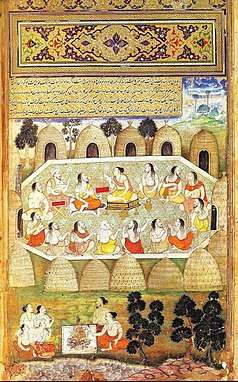Naimiṣāraṇya (forest)
Naimiṣāraṇya (Devanagari: नैमिषारण्य), also referred as Naimisha is a sacred forest frequently mentioned in Puranic literature as well as both the Ramayana and the Mahabharata.[1][2] It is the place where Puranas had been narrated for the first time before a large gathering of sages.[3]The place proper was undoubtedly of much religious efficacy as it was the abode of sixty-thousand Ṛṣis.
The ancient forest corresponds to modern day Nimsar situated along the Gomti River in Sitapur district of Uttar Pradesh, India.[2]
Etymology
The Brahmanas derive the name Naimiṣāraṇya from 'nimiṣā', "a twinkling of the eye"; hence Naimiṣāraṇya means "a forest or pool where in the twinkling of an eye sage Gauramukha destoryed an army of Asuras." Naimiṣīyā figure for the first time in the Brāhmaṇas and the Upaniṣadic Literature. These words denote the dwellers in the Naimiṣa forest. They are mentioned in the Kāthaka-Saṃhitā and Brāhmaṇas being clearly of special sanctity.
In the Varaha Purana, it has been described as the region where Daityas (demons) were slain within a nimiśa (smallest unit of time) and the place was made a abode of peace.[3]
Legend
Ramayana
According to the Rāmāyaṇa, Naimiṣa was situated along the Gomati River. The sanctity attached to the place was such that Rāma desired to celebrate Aśvamedha sacrifice in this forest, and accordingly, placing his younger brother Lakṣmana assisted by the priests in charge of the steed, himself went to the forest. It was during the sacrifice that Valmiki with his disciples came there and constructed some comfortable huts at a distance. Then Lava and Kuśa recited the whole Ramayana which convinced Rama that they were the twin sons of Sītā. Ultimately, Mother Earth appeared at Sita's invocation and, proving her innocence, accompanied her into the bowels of the earth.
Mahabharata
In the Adi Parva of the Mahabharata, the forest is mentioned as situated towards east (prācīm diśam) of the mountain regions of Himavat which contained many sacred spots. In the epic, there are frequent references to Ṛṣis living in Naimiṣāraṇya and performing sacrifices extending for years.
Here Śaunaka had performed a twelve years sacrifice which was attended by a large number of seers, of whom the most prominent and distinguished was Ugraśrava-Sauti, the son of Romaharṣaṇa. His personality attracts the attention of all the scholars of Indian culture.He is described as well-versed in the Purāṇas which he cultivated with meticulous devotion. Sauti's father Romaharṣaṇa who was a disciple of the great Kṛṣṇa-Dvaipāyana Vyāsa, had once narrated the story of Āstīka before the inhabitants of the forest at the latter's request.
It is also believed that the river Sarasvatī had turned her course towards the east to see the great Ṛṣis (sages) dwelling in the forest.
See also
- Naimisaranya, a temple located at the purported site of Naimisha forest
References
- Knapp, Stephen (2008-05-29). Seeing Spiritual India: A Guide to Temples, Holy Sites, Festivals and Traditions. iUniverse. ISBN 9780595614523.
- Mani, Vettam (1975). Puranic encyclopaedia : a comprehensive dictionary with special reference to the epic and Puranic literature. Robarts - University of Toronto. Delhi : Motilal Banarsidass. pp. 517.
- Sharma, Jugal Kishor (1993). Punya Bhoomi Bharat. Suruchi Prakashan. ISBN 9789381500095.
Bibliography
- Pandeya, Rajendra Bihari. “Naimiṣāraṇya in Literature.” Journal of the American Oriental Society, vol. 84, no. 4, 1964, pp. 405–408. JSTOR.
External links
- Wikimapia.org (location)
- Gomati River - Adi Ganga
